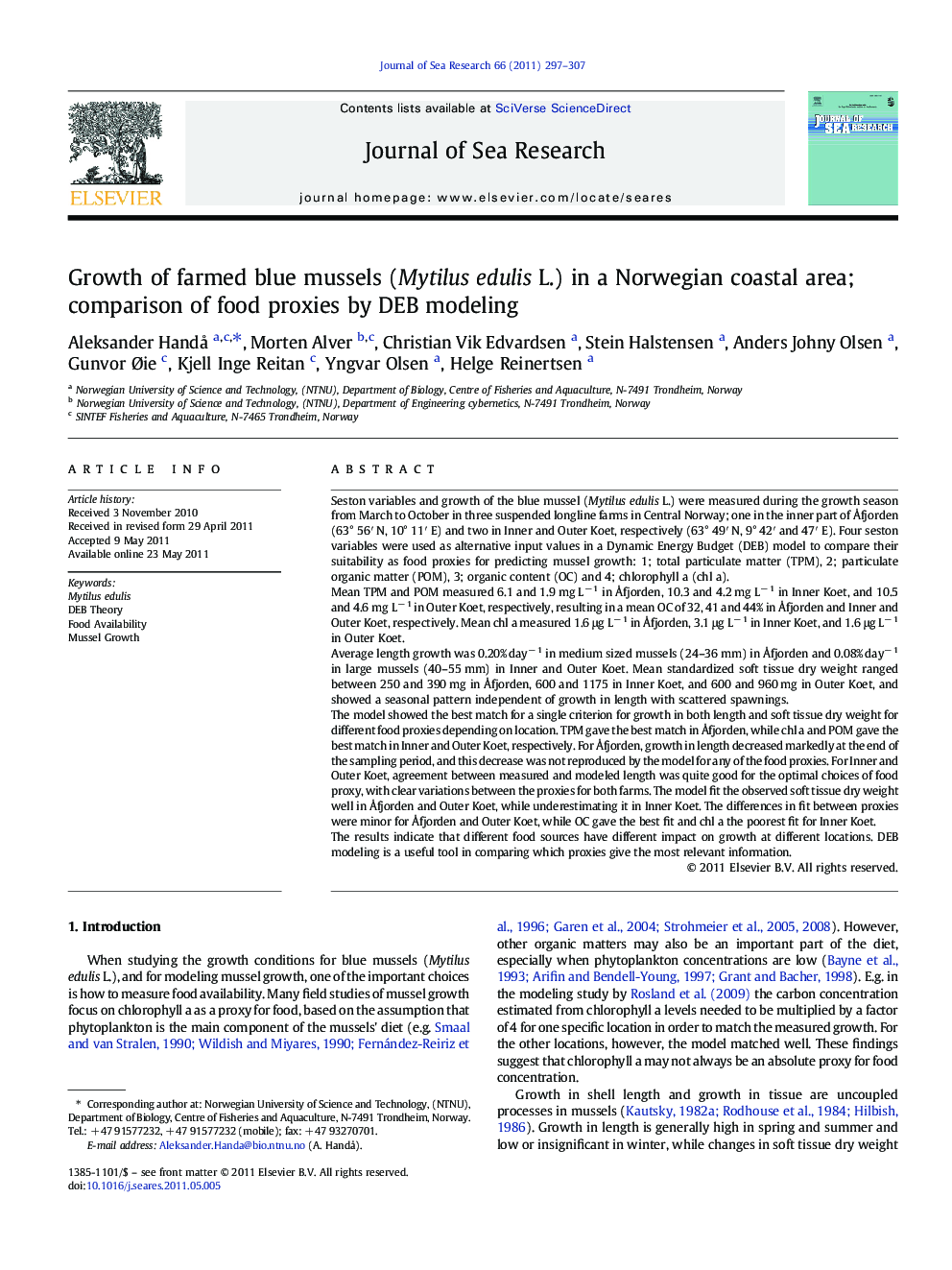| کد مقاله | کد نشریه | سال انتشار | مقاله انگلیسی | نسخه تمام متن |
|---|---|---|---|---|
| 4550024 | 1328124 | 2011 | 11 صفحه PDF | دانلود رایگان |

Seston variables and growth of the blue mussel (Mytilus edulis L.) were measured during the growth season from March to October in three suspended longline farms in Central Norway; one in the inner part of Åfjorden (63° 56′ N, 10° 11′ E) and two in Inner and Outer Koet, respectively (63° 49′ N, 9° 42′ and 47′ E). Four seston variables were used as alternative input values in a Dynamic Energy Budget (DEB) model to compare their suitability as food proxies for predicting mussel growth: 1; total particulate matter (TPM), 2; particulate organic matter (POM), 3; organic content (OC) and 4; chlorophyll a (chl a).Mean TPM and POM measured 6.1 and 1.9 mg L− 1 in Åfjorden, 10.3 and 4.2 mg L− 1 in Inner Koet, and 10.5 and 4.6 mg L− 1 in Outer Koet, respectively, resulting in a mean OC of 32, 41 and 44% in Åfjorden and Inner and Outer Koet, respectively. Mean chl a measured 1.6 μg L− 1 in Åfjorden, 3.1 μg L− 1 in Inner Koet, and 1.6 μg L− 1 in Outer Koet.Average length growth was 0.20% day− 1 in medium sized mussels (24–36 mm) in Åfjorden and 0.08% day− 1 in large mussels (40–55 mm) in Inner and Outer Koet. Mean standardized soft tissue dry weight ranged between 250 and 390 mg in Åfjorden, 600 and 1175 in Inner Koet, and 600 and 960 mg in Outer Koet, and showed a seasonal pattern independent of growth in length with scattered spawnings.The model showed the best match for a single criterion for growth in both length and soft tissue dry weight for different food proxies depending on location. TPM gave the best match in Åfjorden, while chl a and POM gave the best match in Inner and Outer Koet, respectively. For Åfjorden, growth in length decreased markedly at the end of the sampling period, and this decrease was not reproduced by the model for any of the food proxies. For Inner and Outer Koet, agreement between measured and modeled length was quite good for the optimal choices of food proxy, with clear variations between the proxies for both farms. The model fit the observed soft tissue dry weight well in Åfjorden and Outer Koet, while underestimating it in Inner Koet. The differences in fit between proxies were minor for Åfjorden and Outer Koet, while OC gave the best fit and chl a the poorest fit for Inner Koet.The results indicate that different food sources have different impact on growth at different locations. DEB modeling is a useful tool in comparing which proxies give the most relevant information.
► We measured seston variables and mussel growth in three longline farms.
► We studied predictions of length and dry weight from a DEB model.
► Food availability did not appear to restrict growth during summer.
► Different food sources have different impact on growth at different locations.
► Total seston, organic matter and chl a gave the best fit, respectively.
Journal: Journal of Sea Research - Volume 66, Issue 4, November 2011, Pages 297–307